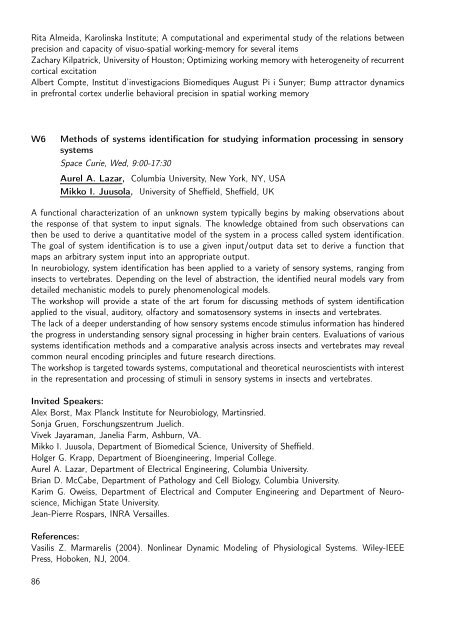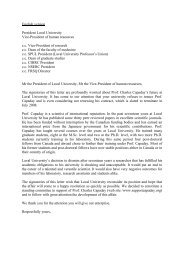Untitled - Laboratory of Neurophysics and Physiology
Untitled - Laboratory of Neurophysics and Physiology
Untitled - Laboratory of Neurophysics and Physiology
Create successful ePaper yourself
Turn your PDF publications into a flip-book with our unique Google optimized e-Paper software.
Rita Almeida, Karolinska Institute; A computational <strong>and</strong> experimental study <strong>of</strong> the relations between<br />
precision <strong>and</strong> capacity <strong>of</strong> visuo-spatial working-memory for several items<br />
Zachary Kilpatrick, University <strong>of</strong> Houston; Optimizing working memory with heterogeneity <strong>of</strong> recurrent<br />
cortical excitation<br />
Albert Compte, Institut d’investigacions Biomediques August Pi i Sunyer; Bump attractor dynamics<br />
in prefrontal cortex underlie behavioral precision in spatial working memory<br />
W6<br />
Methods <strong>of</strong> systems identification for studying information processing in sensory<br />
systems<br />
Space Curie, Wed, 9:00-17:30<br />
Aurel A. Lazar, Columbia University, New York, NY, USA<br />
Mikko I. Juusola, University <strong>of</strong> Sheffield, Sheffield, UK<br />
A functional characterization <strong>of</strong> an unknown system typically begins by making observations about<br />
the response <strong>of</strong> that system to input signals. The knowledge obtained from such observations can<br />
then be used to derive a quantitative model <strong>of</strong> the system in a process called system identification.<br />
The goal <strong>of</strong> system identification is to use a given input/output data set to derive a function that<br />
maps an arbitrary system input into an appropriate output.<br />
In neurobiology, system identification has been applied to a variety <strong>of</strong> sensory systems, ranging from<br />
insects to vertebrates. Depending on the level <strong>of</strong> abstraction, the identified neural models vary from<br />
detailed mechanistic models to purely phenomenological models.<br />
The workshop will provide a state <strong>of</strong> the art forum for discussing methods <strong>of</strong> system identification<br />
applied to the visual, auditory, olfactory <strong>and</strong> somatosensory systems in insects <strong>and</strong> vertebrates.<br />
The lack <strong>of</strong> a deeper underst<strong>and</strong>ing <strong>of</strong> how sensory systems encode stimulus information has hindered<br />
the progress in underst<strong>and</strong>ing sensory signal processing in higher brain centers. Evaluations <strong>of</strong> various<br />
systems identification methods <strong>and</strong> a comparative analysis across insects <strong>and</strong> vertebrates may reveal<br />
common neural encoding principles <strong>and</strong> future research directions.<br />
The workshop is targeted towards systems, computational <strong>and</strong> theoretical neuroscientists with interest<br />
in the representation <strong>and</strong> processing <strong>of</strong> stimuli in sensory systems in insects <strong>and</strong> vertebrates.<br />
Invited Speakers:<br />
Alex Borst, Max Planck Institute for Neurobiology, Martinsried.<br />
Sonja Gruen, Forschungszentrum Juelich.<br />
Vivek Jayaraman, Janelia Farm, Ashburn, VA.<br />
Mikko I. Juusola, Department <strong>of</strong> Biomedical Science, University <strong>of</strong> Sheffield.<br />
Holger G. Krapp, Department <strong>of</strong> Bioengineering, Imperial College.<br />
Aurel A. Lazar, Department <strong>of</strong> Electrical Engineering, Columbia University.<br />
Brian D. McCabe, Department <strong>of</strong> Pathology <strong>and</strong> Cell Biology, Columbia University.<br />
Karim G. Oweiss, Department <strong>of</strong> Electrical <strong>and</strong> Computer Engineering <strong>and</strong> Department <strong>of</strong> Neuroscience,<br />
Michigan State University.<br />
Jean-Pierre Rospars, INRA Versailles.<br />
References:<br />
Vasilis Z. Marmarelis (2004). Nonlinear Dynamic Modeling <strong>of</strong> Physiological Systems. Wiley-IEEE<br />
Press, Hoboken, NJ, 2004.<br />
86



